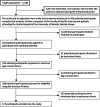Evaluation of the Golden Proportion, Golden Percentage, and Recurring Esthetic Dental Proportion in Kenyans of African Descent
- PMID: 38970240
- PMCID: PMC11226540
- DOI: 10.1002/cre2.923
Evaluation of the Golden Proportion, Golden Percentage, and Recurring Esthetic Dental Proportion in Kenyans of African Descent
Abstract
Objectives: To evaluate the validity of the Golden Proportion, Golden Percentage, and Recurring Esthetic Dental (RED) Proportion among Kenyans of African descent with naturally well-aligned teeth.
Materials and methods: Standardized frontal photographic images of the smiles of 175 participants aged 18-35 years were obtained, and Adobe Photoshop was used to analyze and measure the frontal widths of the maxillary central and lateral incisors and canines in triplicate. The average teeth widths were calculated to determine the existence of the Golden Proportion, Golden Percentage, and RED Proportion, and their validity using independent sample t-tests to compare the differences in the mean teeth widths at α < 0.05.
Results: The number of male and female participants was 107 (61.1%) and 68 (38.9%), respectively. The Golden Proportion between the maxillary central and lateral incisors was found in 4.0% on the right and 2.8% on the left of all the participants, but between the maxillary lateral incisors and canines was found in only 0.6% on the right of male participants (p < 0.0001). The RED Proportion between the maxillary lateral and central incisors was in the range of 67%-70%, and between the canines and lateral incisors was 82%-84% (p < 0.0001). The proportion of RED was not constant, and gradually increased distally. The Golden Percentage of 15% was observed in the lateral incisors bilaterally; however, in the central incisors and the canines, the Golden Percentage was 22% and 12%, respectively.
Conclusion: The Golden and RED Proportions were invalid determinants of anterior teeth proportions. The Golden Percentage existed only in the lateral incisors. The Golden Proportion, RED Proportion, and Golden Percentage theories may not be applicable to all populations when designing smiles. Racial and ethnic backgrounds are important considerations to establish objective quantifiable values of anterior tooth proportions that are beneficial for esthetic restorations.
Keywords: Golden Percentage; Golden Proportion; Recurring Esthetic Dental Proportion; maxillary anterior tooth proportions.
© 2024 The Author(s). Clinical and Experimental Dental Research published by John Wiley & Sons Ltd.
Conflict of interest statement
The authors declare no conflicts of interest.
Figures



References
-
- Alhabahbah, A. M. , Aburumman K. K., Al‐Shamout R. A., et al. 2016. “Evaluating the Validity of Mathematical Proportions in Maxillary Anterior Teeth in Jordanian Population.” Journal of the Pakistan Dental Association 36, no. 2:295–300.
-
- Ariemba, R. , Gathece L., and Maina S.. 2017. “Correlation Between Inner Canthal Width and the Mesio‐Distal Widths of the Maxillary Anterior Teeth in a Kenyan Population of African Descent.” East African Medical Journal 94, no. 4: 282–289.
-
- Azimi, M. , Dinparvar M., Teimourian H., and Farhadian M.. 2017. “Evaluating Recurring Esthetic Dental Proportion (RED) and Golden Proportion in Natural Dentition.” Avicenna Journal of Dental Research 9, no. 1: e30267. 10.5812/ajdr.30267. - DOI
-
- Aziz, M. , and Hossain M. Z.. 2017. “Validity of Mathematical Proportions in Maxillary Anterior Teeth Among Bangladeshi Population.” APOS Trends in Orthodontics 7, no. 1: 41–48. 10.4103/2321-1407.199174. - DOI
MeSH terms
Grants and funding
LinkOut - more resources
Full Text Sources

